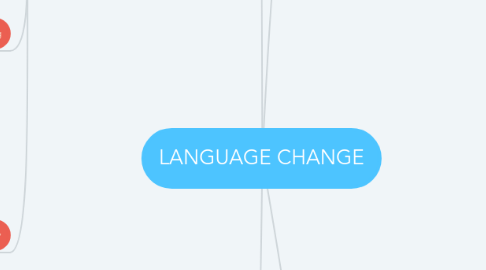
1. Mechanisims of Language Change
1.1. Sound Change
1.1.1. the way members of a speech community pronounce particular sounds
1.1.1.1. Conditioned sound change
1.1.1.1.1. conditioned by, phonetic environment
1.1.1.2. Unconditioned sound change
1.1.1.2.1. involving several related sounds.
1.1.1.3. Chain shifts
1.1.1.3.1. a set of changes
1.1.1.4. Processes of sound change
1.1.1.4.1. assimilation
1.1.1.4.2. dissimilation,
1.1.1.4.3. the loss of a sound
1.1.1.4.4. Excrescence
1.1.1.4.5. haplology
1.2. Borrowing
1.2.1. The adoption of elements from another language or dialect is linguistic
1.2.2. When an element is borrowed from a language which is culturally or politically dominant, the motive is PRESTIGE.
1.2.3. Often borrowed items are changed to conform to native linguistic rules, a process known as adaptation
1.2.4. Borrowing can also lead to morphological change in the recipient language
1.2.4.1. Latin datum/data, vertebra/vertebrae, nucleus/nuclei, index/indices, matrix/matrices, analysis/analyses,
1.2.4.2. Greek criterion/criteria, and stigma/stigmata.
1.2.4.3. (Some speakers of English form the plural of these nouns by adding -s,
1.3. Analogy
1.3.1. modification or creation of linguistic forms
1.3.1.1. Children overgeneralize
1.3.1.1.1. most verbs (add -ed, so the past tense of walk is walked),
1.3.2. Hypercorrection
1.3.2.1. Is mistakenly assumed to be more correct than a correct form, which it replaces.
1.3.2.1.1. Marthy for Martha
2. Linguistic reconstruction and Language Families
2.1. The comparative Method
2.1.1. Assembling cognates and establishing sound correspondences
2.1.1.1. are words in two or more languages which refer to the same referent with similar sequences of sounds EXAMPLE
2.1.1.1.1. (body parts, kinship terms, numerals, household items, and articles and pronouns)
2.2. Internal Reconstruction
2.2.1. analysis of forms within a single language
2.2.1.1. Nominative singular Nominative plural lamb lembir ‘lamb’ kalb kelbir ‘calf’ blat bletir ‘leaf’
2.2.1.1.1. The /a/ /e/ alternation in these allomorphs springs from a single phoneme /a/, which became /e/ before /-ir/.
3. Historical Linguistics and Culture
3.1. its range of variation over time, and the processes by which it can change,
3.2. Piecing together linguistic artifacts in order to better understand earlier civilizations through the interpretation of their reconstructed languages.
3.2.1. in Indo-European languages we find related words with the meaning ‘dog’
3.2.1.1. This tells us that speakers of Proto-Indo-European were familiar with dogs
3.3. Languages change over time to meet the changing situations and needs of their speakers
3.3.1. early Germanic writing was done on wood
3.3.1.1. the original meaning of Old English wrı¯tan (write) was ‘scratch.’
4. Causes of Language Change
4.1. Articulatory Simplification
4.1.1. If a sequence of sounds in a language is difficult to pronounce, or is unnecessarily complex, it is likely to be simplified
4.1.2. Example: /noz&'ka/ " Small foot " /nos&ka/
4.2. Regularization
4.2.1. Language exhibit many mechanisms for maintaining their integrity and regularity
4.2.2. a regular pattern is easier to learn than a pattern with lots of exceptions
4.2.3. speakers of a language will often extend a pattern from Example:
4.2.4. The past tense of the verb fell (as in to fell a tree) is felled
4.3. Language Contact
4.3.1. Contact with speakers of another language
4.3.1.1. Members of the conquered speech community are motivated to use the language of their conquerors to gain access to social resources
4.3.2. Borrowing
4.3.2.1. adopts (or adapts) the name for a new invention or concept from another language. Example:
4.3.2.1.1. baseball was adopted by the Japanese
4.3.2.1.2. adapted to Japanese phonology
4.3.2.1.3. syllable structure as besuboru
4.3.3. loan words
4.3.3.1. adapt the original word to the phonological constraints of the borrowing language
4.3.3.1.1. Easier for speakers of other languages to adopt the English names of new concepts and inventions than to coin their own Example:
